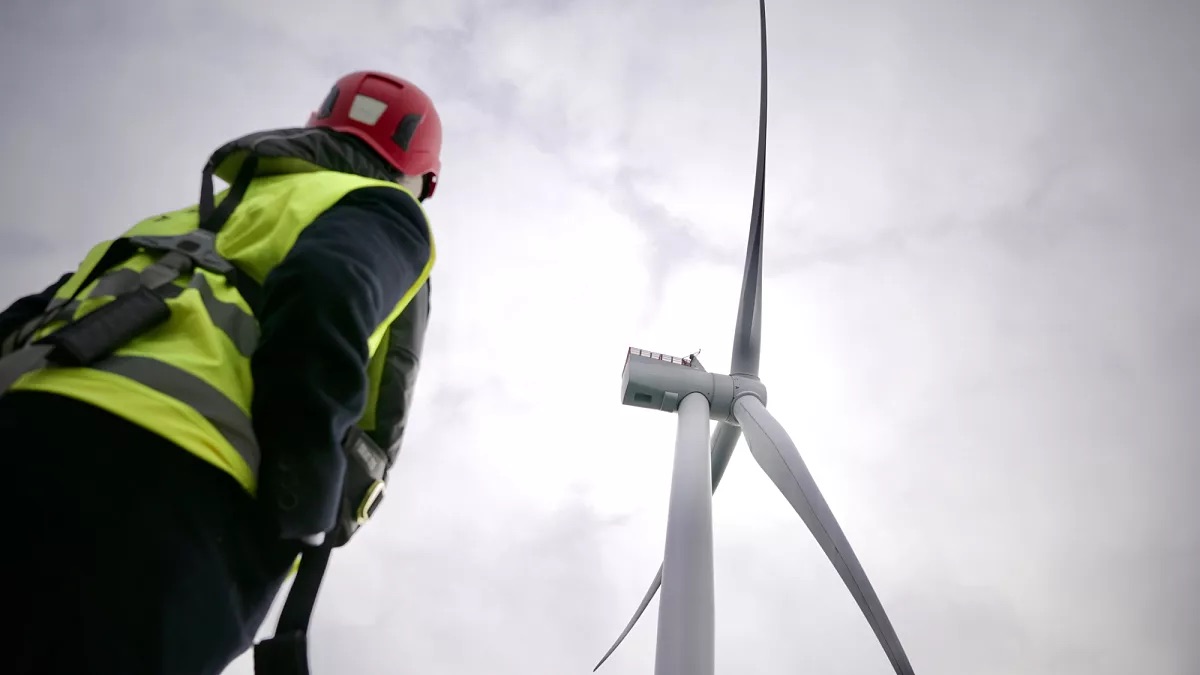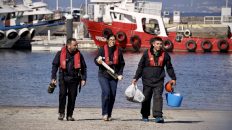Rising from the Baltic Sea, Kriegers Flak is more than Denmark’s largest offshore wind farm. It’s a pioneering energy bridge between Denmark and Germany, helping balance electricity prices and strengthen energy security for both countries — all while providing a clean alternative to fossil fuels. As Europe seeks to secure its energy future, wind parks like Kriegers Flak are set to play a growing role.
“Europe needs more homegrown renewable electricity like this,” says Giles Dickson, CEO of WindEurope, an industry body representing over 600 companies. “That means more energy security, which in turn means economic security and national security.”
The numbers are ambitious. The EU wants to grow its offshore wind capacity from 20 gigawatts today to 360 gigawatts by 2050. It’s a massive undertaking, backed by policy support and rapid technological innovation.
Bigger turbines, smarter control
At the Port of Esbjerg on Denmark’s west coast, the future is already taking shape. From here, Swedish energy giant Vattenfall remotely manages more than 1,200 offshore turbines across four countries. Algorithms are playing a growing role in this digital transition: according to Laura Ørsted, who heads Vattenfall’s operational control centre, automation is key to keeping up with the growth in turbine numbers.
As turbines get taller and more powerful, ports like Esbjerg are expanding to meet the logistical demands. Having already handled 80% of Europe’s offshore wind installations, the port is now reclaiming more land to accommodate next-generation equipment.
“One of the challenges with offshore wind is that it needs very large port space, port capacity — and that’s also why there aren’t sufficient offshore wind ports in Europe today,” says Dennis Jul Pedersen, the port’s CEO. “We are lucky here that we have been able to develop the port in line with what the industry needs, and we will also be very, very busy going forward.”
The maintenance cost challenge
Getting turbines installed at sea isn’t easy — or cheap. Specialised vessels like the Wind Osprey, operated by Danish offshore services company Cadeler, are critical. With extendable legs that reach down to the seabed, they form stable platforms for lifting and assembling massive components.
“Everything’s getting bigger,” says Captain Matthew Christie of the Wind Osprey. “We’ve just had a new crane fitted — it’s longer and has a bigger lifting capacity, because the tower sections are taller now.”
A single day of operation for these ships can cost hundreds of thousands of euros. And once the turbines are up, keeping them running smoothly is another major challenge.
Offshore turbines are battered by salt water and storms. Unlike land-based units, they’re hard to access — requiring boats or helicopters, and only during calm weather. This makes maintenance one of the most expensive parts of offshore wind operations, accounting for up to a third of total costs.
“The cost of maintenance is actually quite a large fraction of the total levelised cost of energy,” says Simon Watson, professor of wind energy systems at TU Delft. “There’s a big interest in trying to reduce that to make offshore wind energy more cost effective.”
Robots to the rescue?
The sector is increasingly looking to robotics as part of the solution. In Latvia, a company called Aerones has developed a climbing robot that can inspect and repair turbine blades more quickly — and safely — than human workers.
These robots can sand, coat, and inspect blades for damage, dramatically reducing downtime and keeping the turbines turning.
“The largest blades in the world are exceeding 120 metres,” says Aerones CEO Dainis Kruze. “We optimise the robots for speed, so the turbines have far less downtime while we’re doing the job.”
At their Riga factory, Aerones is now producing dozens of these machines each month to keep up with demand. The long-term vision? Autonomous maintenance robots for every turbine, overseen by technicians rather than operated manually.
“As the robots become smarter, we try to implement algorithms so the operator would be kind of overseeing the AI agents doing the work, not so much being involved himself, moving the robot left or right,” adds Aerones CTO Janis Putrams.
Wind at Europe’s back
Despite the challenges, momentum is strong. The WindEurope Annual Event in Copenhagen highlighted just how much investment, research, and international collaboration is going into this growing sector.
By 2030, the European wind industry — both onshore and offshore — is expected to employ over 900,000 people and contribute more than €100 billion to the EU economy.
“There are the jobs, the growth, the investment that comes locally from building and operating these wind farms and manufacturing the turbines and all the equipment, the grid equipment, that is part of wind energy,” says WindEurope’s Giles Dickson.
As Europe works to reduce reliance on fossil fuels and unstable energy imports, offshore wind is fast becoming a pillar of its strategy. Scaling up isn’t easy, but with innovation and smart investment, the continent is turning its coastal winds into a powerful force for change.





